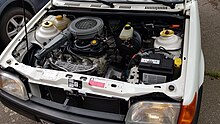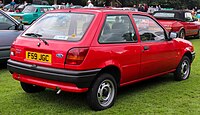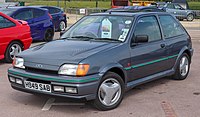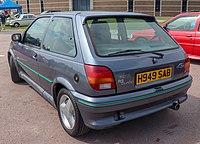Ford Fiesta (third generation)
This article needs additional citations for verification. (February 2015) |
| Ford Fiesta Mk3 | |
|---|---|
| Dimensions | |
| Wheelbase | 2,446 mm (96.3 in) |
| Length | 3,743 mm (147.4 in) |
| Width | 1,606 mm (63.2 in) |
| Height | 1,321 mm (52.0 in) |
| Chronology | |
| Predecessor | Ford Fiesta (second generation) |
| Successor | Ford Fiesta (fourth generation) |
The Ford Fiesta Mk3 was the third generation of the
The Fiesta Mk3 also spawned a high-cube panel van version in 1991, the Courier, and also shared its platform with the Ka of 1996, which was derived from the Fiesta Mk4.
History
The third generation Fiesta, codenamed BE-13 was unveiled at the end of 1988 and officially went on sale in February of the following year with UK sales commencing in April. The car was based on a new platform ditching the old car's rear beam axle for a semi-independent torsion beam arrangement and looked radically different, addressing the principal weakness of the
This model had the longest production life of any Fiesta to date, achieved the highest yearly sales of any Fiesta in the early 1990s – achieving a sales volume of 1 million units inside the first two years of production. A Fiesta-derived van, the Courier, was launched in 1991.
In the British market,
The mild Fiesta S was the first sporting version of the new Fiesta, arriving in the first half of 1989. It was available with two versions of the CVH engine; either a fuel injected 1.4 or a 1.6-litre Weber carburetted version without a catalytic converter. The S models had either 71 or 90 PS (52 or 66 kW; 70 or 89 bhp), respectively. The 1.6 S was manufactured until August 1991; it was replaced by a 16-valve, 1.8-liter engine with 105 PS (77 kW; 104 bhp) in mid-1992. The "proper" XR2i was launched in October 1989
From 1995 the vehicle was built and sold at the same time as the new Mark 4. To distinguish the car, trim levels were revised, and it was marketed as the "Fiesta Classic", with a small range consisting of Classic, Classic Quartz, and Classic Cabaret models, and a ‘Special Edition’ Frascati model. Production of these models took place in Valencia, Spain. This version continued until production finally ceased in early 1997.
Commercial models
As with the Mark 2, this generation was available as a panelled van in many markets. This range offered a limited number of engines. From late September 1990 the van was also available with the new catalyzed central injection (CFi) 1.4-liter petrol engine.[4]
A box van version of the Fiesta appeared in the summer of 1991, but was sold as the Ford Courier.
RS Turbo
The Fiesta RS Turbo was a performance model of the Fiesta Mk3. It was introduced in April 1990 and production continued until 1992.[5]
Based on the XR2i, introduced a year earlier, it was visually similar. The main differences were 14" alloy wheels (an inch larger and of a different design than those fitted to the XR2i) with 185/55 VR14 Pirelli P600 tyres, green rather than blue stripe mouldings, colour-coded rear spoiler and door pillars, opening rear quarter windows, green tinted glass and RS bonnet louvres. Anti-lock brakes and a "Quickclear" heated front windscreen were options at extra cost.
Inside the car the differences included Recaro seats trimmed in "Ascot In Raven" material and a grey leather trimmed gear knob and a three-spoke steering wheel (as opposed to the two-spoke used in the XR2i), which also had the RS Turbo logo embossed on the centre cap.
The RS Turbo's CVH engine retained the same 1597cc capacity as the XR2i, but had a lower compression ratio of 8:1. The Garrett T2 turbocharger supplied 8 psi (55 kPa) of boost and was chosen as space between the engine and radiator prevented the use of the larger T3 from the Escort RS Turbo. As with the Escort, an air-to-air intercooler was fitted, although this was slightly larger on the Fiesta. The quoted power output was 133ps at 5500rpm, with 183 nm of torque at 2400rpm which gave the car a top speed of 133 mph and a 0-60 of 7.9 seconds.
The car was not generally well received with reviews citing poor handling and uncommunicative steering as its weak points. The spiralling insurance premiums brought on by the British joyriding epidemic of the early 1990s did not help either, with the car being a popular target for thieves.
RS1800
The Fiesta RS1800 was introduced as the replacement for the RS Turbo in 1992. The turbocharged 1.6 L CVH engine from the RS Turbo was replaced by a 1.8 L version of the Zetec engine, and had a similar claimed maximum power output of 130 PS (96 kW; 130 bhp).
Specifications
-
Fiesta Mk3 3-door (pre-facelift)
-
Fiesta Mk3 5-door (post-facelift)
-
Fiesta RS Turbo
-
Fiesta RS Turbo
-
Fiesta Mk3 van
-
Interior
References
- ISBN 978-3-444-00482-7.
- ^ "The phut-phut Fiesta". Autocar and Motor (8 July 1992).
- ^ "Still going strong, Ford's youthful spirited Fiesta is celebrating its 30th birthday". Media.Ford.com. 25 August 2006.
- ISSN 0010-3063.
- ^ AdrianFRST (19 April 2001). "Performance Fiesta Mk3 History". fiestaturbo.com. Retrieved 13 February 2015.








